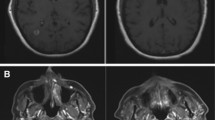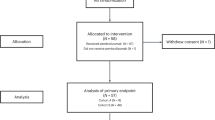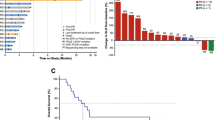Abstract
Patients with progressive primary brain tumors (PBT) are attracted to promising new treatments, even prior to convincing data. Anti-PD1 immunotherapies have been in the spotlight since publication of groundbreaking results for metastatic melanoma with pembrolizumab (PBL). Our objective was to report on the response and toxicity of PBL in patients with advanced PBT. We retrospectively reviewed the charts of 22 patients (17 adults and 5 children) with recurrent central nervous system tumors treated with PBL. We analyzed prior antineoplastic therapies, steroid usage, and outcomes. Patients received a median of two neoplastic therapies prior to PBL, and a median of three infusions of PBL in adults and four in children. Twelve patients (9 adults and 3 children) started PBL on steroids (median dose in adults 4 mg; range 2–8, and in children 1.5 mg, range 0.5–4) and five patients received steroids later during PBL treatment. Twelve patients (10 adults and 2 children) received concomitant bevacizumab with PBL. Side effects were minimal. All patients showed progressive tumor growth during therapy. Median OS from the start of PBL was 2.6 months in adults and 3.2 months in children. Two GB patients underwent tumor resection following treatment with PBL. Tumor-lymphocytic response in these cases was unremarkable, and PD-L1 immuno-staining was negative. In this series of 22 patients with recurrent primary brain tumors, PBL showed no clinical or histologic efficacy. We do not recommend further use of PBL for recurrent PBT unless convincing prospective clinical trial data are published.

Similar content being viewed by others
References
Stupp R, Mason WP, van den Bent MJ et al (2005) Radiotherapy plus concomitant and adjuvant temozolomide for glioblastoma. N Engl J Med 352:987–996
Friedman HS, Prados MD, Wen PY et al (2009) Bevacizumab alone and in combination with irinotecan in recurrent glioblastoma. J Clin Oncol 27:4733–4740
Westphal M, Hilt DC, Bortey E et al (2003) A phase 3 trial of local chemotherapy with biodegradable carmustine (BCNU) wafers (Gliadel wafers) in patients with primary malignant glioma. Neuro Oncol 5:79–88
Bokstein F, Blumenthal DT, Corn BW et al (2016) Stereotactic radiosurgery (SRS) in high-grade glioma: judicious selection of small target volumes improves results. J Neurooncol 126:551–557
Fogh SE, Andrews DW, Glass J et al (2010) Hypofractionated stereotactic radiation therapy: an effective therapy for recurrent high-grade gliomas. J Clin Oncol 28:3048–3053
Cage TA, Samagh SP, Mueller S et al (2013) Feasibility, safety, and indications for surgical biopsy of intrinsic brainstem tumors in children. Childs Nerv Syst 29:1313–1319
Ribas A, Puzanov I, Dummer R et al (2015) Pembrolizumab versus investigator-choice chemotherapy for ipilimumab-refractory melanoma (KEYNOTE-002): a randomised, controlled, phase 2 trial. Lancet Oncol 16:908–918
Zandberg DP, Strome SE (2014) The role of the PD-L1:PD-1 pathway in squamous cell carcinoma of the head and neck. Oral Oncol 50:627–632
Tykodi SS (2014) PD-1 as an emerging therapeutic target in renal cell carcinoma: current evidence. Onco Targets Ther 7:1349–1359
Garon EB, Rizvi NA, Hui R et al (2015) Pembrolizumab for the treatment of non-small-cell lung cancer. N Engl J Med 372:2018–2028
Herbst RS, Baas P, Kim DW et al (2015) Pembrolizumab versus docetaxel for previously treated, PD-L1-positive, advanced non-small-cell lung cancer (KEYNOTE-010): a randomised controlled trial. Lancet 387:1540–1550
Frampton GM, Fichtenholtz A, Otto GA et al (2013) Development and validation of a clinical cancer genomic profiling test based on massively parallel DNA sequencing. Nat Biotechnol 31:1023–1031
Robert C, Schachter J, Long GV et al (2015) Pembrolizumab versus ipilimumab in advanced melanoma. N Engl J Med 372:2521–2532
Robert C, Long GV, Brady B et al (2015) Nivolumab in previously untreated melanoma without BRAF mutation. N Engl J Med 372:320–330
Weber JS, D’Angelo SP, Minor D et al (2015) Nivolumab versus chemotherapy in patients with advanced melanoma who progressed after anti-CTLA-4 treatment (CheckMate 037): a randomised, controlled, open-label, phase 3 trial. Lancet Oncol 16:375–384
Larkin J, Hodi FS, Wolchok JD (2015) Combined nivolumab and ipilimumab or monotherapy in untreated melanoma. N Engl J Med 373:1270–1271
Borghaei H, Paz-Ares L, Horn L et al (2015) Nivolumab versus docetaxel in advanced nonsquamous non-small-cell lung cancer. N Engl J Med 373:1627–1639
Seiwert TY, Burtness B, Mehra R et al (2016) Safety and clinical activity of pembrolizumab for treatment of recurrent or metastatic squamous cell carcinoma of the head and neck (KEYNOTE-012): an open-label, multicentre, phase 1b trial. Lancet Oncol. doi:10.1016/S1470-2045(16)30066-3
Moskowitz CH, Ribrag V, Michot JM et al (2014) PD-1 blockade with the monoclonal antibody pembrolizumab (MK-3475) in patients with classical Hodgkin lymphoma after brentuximab vedotin failure: preliminary results from a phase 1b study (KEYNOTE-013). In: 56th annual meeting of the American Society of Hematology, San Francisco, California
Freeman GJ, Long AJ, Iwai Y et al (2000) Engagement of the PD-1 immunoinhibitory receptor by a novel B7 family member leads to negative regulation of lymphocyte activation. J Exp Med 192:1027–1034
Iwai Y, Ishida M, Tanaka Y, Okazaki T, Honjo T, Minato N (2002) Involvement of PD-L1 on tumor cells in the escape from host immune system and tumor immunotherapy by PD-L1 blockade. Proc Natl Acad Sci USA 99:12293–12297
Zeng J, See AP, Phallen J et al (2013) Anti-PD-1 blockade and stereotactic radiation produce long-term survival in mice with intracranial gliomas. Int J Radiat Oncol Biol Phys 86:343–349
Sampson JH, Vlahovic G, Solmaz SS et al (2015) Preliminary safety and activity of nivolumab and its combination with ipilimumab in recurrent glioblastoma (GBM): CHECKMATE-143. J Clin Oncol 2015:33
Sampson JH, Vlahovic G, Desjardins A et al (2014) Randomized phase IIb study of nivolumab (anti-PD-1; BMS-936558, ONO-4538) alone or in combination with ipilimumab versus bevacizumab in patients (pts) with recurrent glioblastoma (GBM). J Clin Oncol 32:5
WM P (2001) Brain drug targeting: the future of brain drug development. Cambridge University Press, Cambridge
Cohen JV, Alomari AK, Vortmeyer AO et al (2016) Melanoma brain metastasis pseudoprogression after pembrolizumab treatment. Cancer Immunol Res 4:179–182
Tumeh PC, Harview CL, Yearley JH et al (2014) PD-1 blockade induces responses by inhibiting adaptive immune resistance. Nature 515:568–571
Nduom EK, Wei J, Yaghi NK et al (2016) PD-L1 expression and prognostic impact in glioblastoma. Neuro Oncol 18:195–205
Alexandrov LB, Nik-Zainal S, Wedge DC et al (2013) Signatures of mutational processes in human cancer. Nature 500:415–421
Amayiri N, Tabori U, Campbell B et al (2016) High frequency of mismatch repair deficiency among pediatric high grade gliomas in Jordan. Int J Cancer 138:380–385
Bouffet E, Larouche V, Campbell BB et al (2016) Immune checkpoint inhibition for hypermutant glioblastoma multiforme resulting from germline biallelic mismatch repair deficiency. J Clin Oncol 34:2206–2211
Schumacher TN, Schreiber RD (2015) Neoantigens in cancer immunotherapy. Science 348:69–74
van Thuijl HF, Mazor T, Johnson BE et al (2015) Evolution of DNA repair defects during malignant progression of low-grade gliomas after temozolomide treatment. Acta Neuropathol 129:597–607
Cahill DP, Levine KK, Betensky RA et al (2007) Loss of the mismatch repair protein MSH6 in human glioblastomas is associated with tumor progression during temozolomide treatment. Clin Cancer Res 13:2038–2045
Ngiow SF, McArthur GA, Smyth MJ (2015) Radiotherapy complements immune checkpoint blockade. Cancer Cell 27:437–438
Rothermundt C, Hader C, Gillessen S (2016) Successful treatment with an anti-PD-1 antibody for progressing brain metastases in renal cell cancer. Ann Oncol 27:544–545
Berghoff AS, Kiesel B, Widhalm G et al (2015) Programmed death ligand 1 expression and tumor-infiltrating lymphocytes in glioblastoma. Neuro Oncol 17:1064–1075
Schiff GD, Galanter WL, Duhig J, Lodolce AE, Koronkowski MJ, Lambert BL (2011) Principles of conservative prescribing. Arch Intern Med 171:1433–1440
Mackey TK, Schoenfeld VJ (2016) Going “social” to access experimental and potentially life-saving treatment: an assessment of the policy and online patient advocacy environment for expanded access. BMC Med 14:17
Acknowledgments
We thank Phil Stephens, PhD and Joana Buxhaku from Foundation Medicine who assisted with the analysis of MSI and mutational number on available patient samples. Thank you to Jay A. Jacobson, M.D. of the University of Utah School of Medicine for medical ethics advice. We thank Anat Mordechai, RN from Hadassah Medical Organization for her assistance with clinical data retrieval.
Funding
This research was not funded by outside sources.
Author information
Authors and Affiliations
Corresponding author
Ethics declarations
Conflict of interest
Gilad W. Vainer, MD, PhD served on advisory committees for Pfizer, Roche, and Merck (MSD) regarding immunologic and molecular testing.
Rights and permissions
About this article
Cite this article
Blumenthal, D.T., Yalon, M., Vainer, G.W. et al. Pembrolizumab: first experience with recurrent primary central nervous system (CNS) tumors. J Neurooncol 129, 453–460 (2016). https://doi.org/10.1007/s11060-016-2190-1
Received:
Accepted:
Published:
Issue Date:
DOI: https://doi.org/10.1007/s11060-016-2190-1




